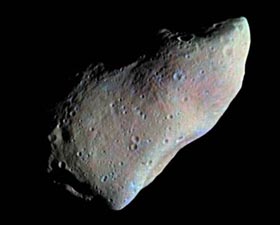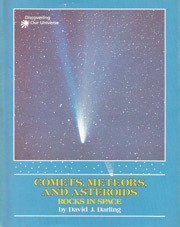COMETS, METEORS, AND ASTEROIDS: Questions and Answers
a book in the Discovering Our Universe series by David Darling

Q. Which was the first asteroid to be discovered?
A. Ceres, in 1801. It is also the largest asteroid.
Q. How much does Ceres weigh?
A. About 1,200,000,000,000,000,000,000 (one thousand,
two hundred billion billion) tons. This makes it about 5,000 times lighter
than the Earth.
Q. Which is the smallest asteroid?
A. Many asteroids are known that are just a few tens
of feet across.
Q. In crossing the asteroid belt between Mars and Jupiter, could a spacecraft
crash into an asteroid?
A. It's possible, but unlikely. None of the space
probes to have ventured through the asteroid belt so far have suffered an
accident, and the asteroids appear to be far enough apart to make the chances
of a crash quite small.
Q. Could an asteroid have killed the dinosaurs?
A. Some scientists think so. They believe that a small
asteroid may have hit the Earth about 65 million years ago. The material
that it threw into the atmosphere may have blocked out the Sun's heat and
made the Earth too cold for the dinosaurs to survive.
Q. Can any asteroid be seen without a telescope or binoculars?
A. Yes, the asteroid Vesta. It is just bright enough
to be seen by someone with good eyesight who knows exactly where to look.
Q. Which comet had the longest tail?
A. In recordd times, the Great Comet of 1843. Its
tail stretched out for 205 million miles (330 million kilometers), or more
than twice the distance from the Earth to the Sun.
Q. Which comet has been seen the most times?
A. Encke's Comet. It takes only 3.3 years to go around
the Sun and has been seen more than 50 times.
Q. What is the highest speed with which meteors enter our atmosphere?
A. About 45 miles per second (72 kilometers per hour).
Q. What is the largest meteorite that ever fell on the United States?
A. The Williamette meteorite, weighing 14 tons, which
fell in Oregon.

